For many prospective dog owners, the appeal of a furry companion often comes with a few hesitations: the inevitable pet hair and the distinct “doggy odor.” While it’s true that all dogs shed to some extent and have their own natural scent, certain breeds are renowned for minimal odors and shedding, making them ideal choices for individuals with allergies or those seeking a cleaner home environment. These breeds often possess unique coat types that reduce dander and hair dispersion, alongside skin characteristics that minimize natural oil production, leading to a much fresher household. Choosing one of these remarkable breeds can significantly ease grooming demands and reduce the need for constant cleaning, allowing you to focus on the joy of companionship. If you’re looking for dogs that don’t shed a lot, understanding these characteristics is key to finding your perfect low-maintenance canine friend.
Discovering Dog Breeds with Minimal Shedding
Non-shedding breeds typically feature a single coat or hair that grows continuously, similar to human hair, rather than having an undercoat that sheds seasonally. This type of coat traps loose hairs, preventing them from scattering around your home. However, to maintain their hypoallergenic qualities and prevent matting, these coats require regular professional grooming or diligent at-home brushing and clipping. Investing in consistent coat care for these breeds can lead to a virtually hair-free home and a happy, comfortable dog.
Poodle
Poodles are perhaps the most famous of the non-shedding breeds, boasting a dense, curly coat that is exceptionally low-shedding. This hypoallergenic coat is a blessing for allergy sufferers, as it traps dander and loose hair rather than releasing it into the environment. Beyond their impressive coats, Poodles are celebrated for their sharp intelligence, making them highly trainable and versatile companions. They excel in various dog sports and activities, thriving on mental stimulation. Regular professional grooming every 4-6 weeks is crucial to prevent matting and maintain the coat’s health and appearance, ensuring your Poodle remains both stylish and comfortable.
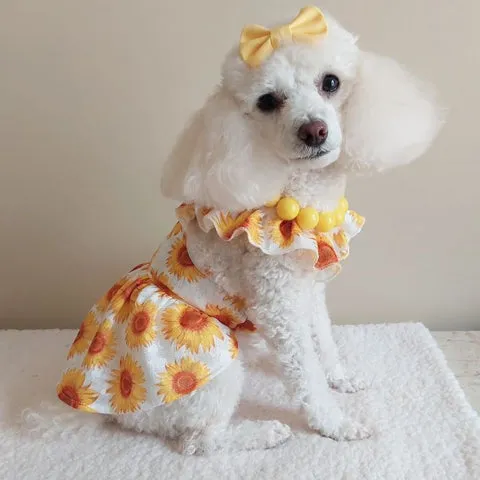 Poodle in a Sunflower Dog Dress
Poodle in a Sunflower Dog Dress
Chinese Crested
The Chinese Crested comes in two distinct varieties, both known for their minimal shedding. The “hairless” type possesses hair only on its head, tail, and feet, while the “powderpuff” is covered in a soft, silky coat. Both varieties are excellent choices for allergy sufferers, though the powderpuff’s long coat requires frequent brushing and grooming to prevent tangles. Chinese Crested dogs are affectionate, lively, and thrive on close companionship with their owners. Their unique appearance combined with their loving nature makes them captivating and devoted pets, often forming strong bonds with their families.
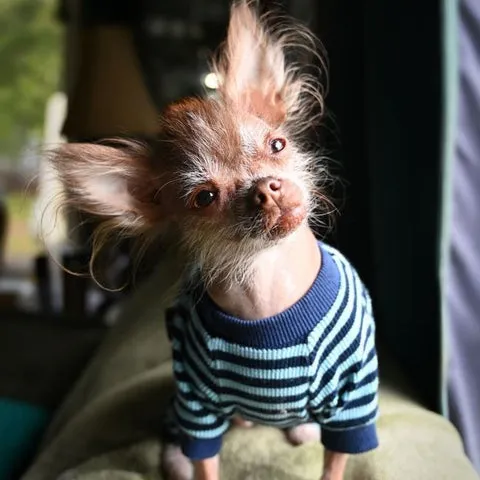 Chinese Crested in Waffle Striped Dog Pajamas
Chinese Crested in Waffle Striped Dog Pajamas
Bichon Frise
With their fluffy, white, powder-puff coats, Bichon Frises are another excellent option for those seeking a non-shedding companion. Their curly double coat catches loose hair and dander, significantly reducing allergens. These cheerful and playful dogs are known for their charming personalities and love for human interaction. Regular grooming, including daily brushing and professional trims every 4-8 weeks, is essential to keep their coats free of mats and looking their best. A well-groomed Bichon is a joy to behold and an even greater joy to live with, bringing endless happiness without excessive shedding. For those considering larger breeds, exploring big house dogs that don’t shed can offer additional options.
Maltese
Maltese dogs are characterized by their elegant, long, silky white coats that are surprisingly low-shedding. Their single coat type is less prone to releasing dander and oils, making them a hypoallergenic favorite. These gentle, playful, and affectionate companion dogs thrive on being with their owners and are often described as true “lap dogs.” While their beautiful coats require daily brushing to prevent tangles and mats, the effort is well worth it for a dog that combines stunning looks with minimal shedding. Regular bathing every few weeks helps maintain their fresh scent and coat health.
Shih Tzu
The Shih Tzu, with its luxurious long, flowing double coat, is another breed that sheds minimally. Originating from Tibetan monasteries, these dogs were bred to be companions and are known for their friendly and outgoing personalities. Their hair grows continuously, similar to human hair, meaning loose strands are typically caught within the coat rather than falling out. Daily brushing is essential to prevent mats and tangles, while professional grooming helps maintain a manageable length. Despite their opulent coats, Shih Tzus are relatively low-allergen pets, making them suitable for many households.
Yorkshire Terrier
Yorkshire Terriers, or Yorkies, possess a fine, silky coat that is more akin to human hair than fur, resulting in very little shedding. This makes them a popular choice for individuals with allergies. Yorkies are small but feisty dogs, full of personality and confidence. While their coats don’t shed much, they do require daily brushing to prevent tangles and regular trims to keep their hair from dragging on the ground. Despite their minimal shedding, their long hair can still gather dirt, so consistent grooming is key to maintaining a clean and healthy Yorkie.
What Are the Least Smelly Dog Breeds?
Beyond shedding, doggy odor is another common concern for owners. While all dogs have a natural scent, some breeds naturally produce less oil in their skin and coats, leading to a significantly reduced “doggy smell.” Regular grooming, including bathing and brushing, is still beneficial for these breeds, but their inherent qualities make them naturally fresher. For those seeking best hypoallergenic dogs that don’t shed, low odor is often an additional desirable trait.
Poodle
In addition to being non-shedding, Poodles are also celebrated for having minimal doggy odor. Their dense, curly coats don’t hold onto smells or oils as readily as those of other breeds. While their coat structure naturally resists odors, regular bathing and grooming every 4-6 weeks remain important to keep Poodles fresh and clean. This routine also helps to remove loose hair and dander, contributing to their overall hypoallergenic qualities. Poodles are energetic, intelligent, and highly trainable, making them top choices for active families seeking a clean and smart companion.
Basenji
The Basenji stands out as one of the least smelly dog breeds due to its short, fine coat and cat-like grooming habits. Basenjis naturally spend hours meticulously cleaning themselves, keeping their coats remarkably tidy. They also possess fewer oil glands compared to many other dog breeds, which significantly reduces the production of the characteristic doggy smell. While Basenjis are exceptionally clean and odor-free, they are known for their high exercise needs and can be quite challenging to train due to their independent and sometimes aloof nature, a trait that contrasts with many breeds that crave constant human interaction.
 Basenji puppy resting on a bed
Basenji puppy resting on a bed
Maltese
Covered in a long, silky white coat, Maltese dogs require daily brushing but typically do not emit a strong odor. Their single coats are less prone to trapping oils and dander that contribute to unpleasant smells. Regular bathing every few weeks will help keep the Maltese smelling fresh and their coat sparkling. Beneath their beautiful exterior, Maltese are playful, affectionate companion dogs who thrive on being with their owners. Their small size makes them delicate, but their loving nature and low-odor qualities make them wonderful indoor pets.
Boston Terrier
The Boston Terrier boasts a short, smooth coat that requires minimal grooming and doesn’t readily absorb odors. Their minimal shedding also contributes to a reduction in household smells. Boston Terriers typically only produce a minor odor when they are in need of a bath. Friendly, lively, and often possessing amusing personalities, Boston Terriers endear themselves to owners with their charming antics. Their small size makes them excellent apartment dwellers, although they do require some daily exercise to stay happy and healthy.
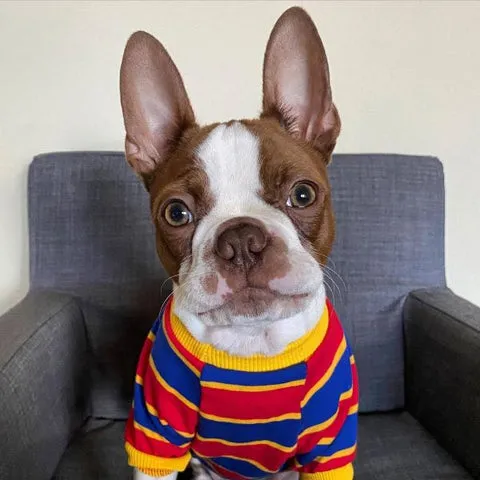 Boston Terrier in a Striped Dog Shirt
Boston Terrier in a Striped Dog Shirt
Scottish Terrier
Scottish Terriers, affectionately known as Scotties, possess a distinctive hard, wiry outer coat and a soft undercoat. This unique coat composition is highly effective at preventing the trapping of odors and minimizes shedding. Scotties typically only require weekly brushing and hand-stripping of dead coat hairs twice a year to maintain their coat’s integrity. While their grooming needs are relatively low, Scotties are energetic dogs that require plenty of exercise to satisfy their lively dispositions. They are independent yet loyal, making excellent and alert watchdogs for their families. For those who prefer water dog breeds that don’t shed, it’s worth noting these breeds often have specific coat types adapted to their aquatic lifestyle.
Schnauzers
Standard, Miniature, and Giant Schnauzers all share a common trait: wiry coats that do not readily trap odor-causing bacteria. While their characteristic beards and leg furnishings require regular cleaning to avoid any localized smells, Schnauzers are generally low-odor dogs. They also shed minimally, needing only occasional brushing and hand-stripping. Schnauzers are intelligent and highly trainable, possessing a blend of terrier independence with a desire to please. They make excellent watchdogs and thrive as active family members. Their minimal grooming requirements, low odor, and loyal temperaments make Schnauzers a top choice for many households, especially those seeking best medium sized dog breeds that don’t shed.
Essential Tips for Managing Dog Shedding
While certain breeds shed less, it’s important to remember that no dog is entirely non-shedding. Even low-shedding breeds will lose some hair. Implementing a consistent grooming and cleaning routine is crucial for minimizing the impact of shedding in your home.
- Regular Brushing: Brush your dog regularly, ideally daily or several times a week, using a slicker brush or a de-shedding tool. Brushing helps to remove dead and loose hair from the coat before it falls onto your furniture and floors, and it also stimulates the skin, promoting a healthier coat.
- Routine Bathing: Bathe your dog monthly or as needed, using a high-quality dog shampoo and conditioner designed for their coat type. Bathing helps to loosen dirt, dander, and dead hair, making it easier to remove during brushing. Ensure thorough rinsing to prevent skin irritation.
- De-shedding Tools: Utilize specialized de-shedding tools like shedding blades or glove brushes, particularly for breeds with undercoats. These tools are designed to effectively remove loose undercoat hair without damaging the topcoat.
- Frequent Vacuuming: Vacuum pet areas frequently, ideally daily, using a vacuum cleaner specifically designed for pet hair. Regular vacuuming helps to remove shed hair from carpets, rugs, and upholstery before it has a chance to accumulate and spread throughout your home.
- Lint Rollers: Keep lint rollers handy for quick clean-ups on furniture, clothing, and pet beds. They are incredibly effective at picking up light debris and stray hairs.
- Air Filter Maintenance: Change your home’s air filters monthly to prevent your heating and air conditioning systems from circulating shed pet hair and dander throughout your living spaces. Clean filters improve air quality.
- Professional Grooming: Consider professional grooming several times a year, especially for breeds with dense or complex coats. Professional groomers have the tools and expertise to thin out thick coats, remove large amounts of loose hair, and provide specialized treatments.
- Dietary Supplements: Discuss with your veterinarian the possibility of giving your dog supplements like omega-3 and omega-6 fatty acids. These can improve skin and coat health, which often leads to a reduction in excessive shedding.
- Maintain Home Humidity: Keep your home cool and adequately humidified. Warm, dry air can increase static electricity, which can make hair shed more easily and stick to surfaces. Cooler, more humid air can help minimize static and hair shedding.
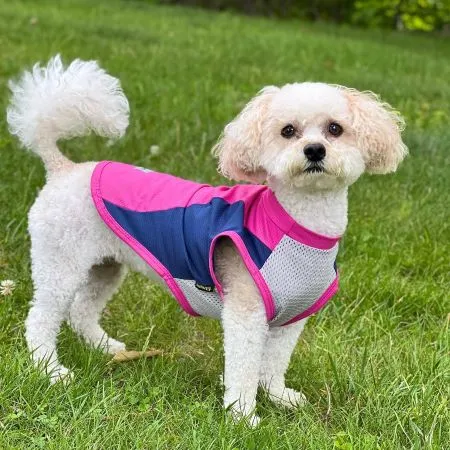 Dog in a Pink UV Sun Protection Dog Shirt
Dog in a Pink UV Sun Protection Dog Shirt
With routine grooming, diligent cleaning, and preventative methods, owners can successfully manage shedding, even in breeds that are prone to heavier shedding. Consistency and persistence are truly the keys to maintaining a clean and comfortable home for both you and your canine companion.
Practical Tips for Reducing Dog Odor
While some breeds naturally have less odor, any dog can benefit from a dedicated care routine that aims to minimize unpleasant smells. Addressing the sources of odor, from their coat to their environment, is crucial for a fresh-smelling home.
- Regular Bathing: Bathe your dog monthly or as needed, using a dog-safe shampoo and conditioner. Bathing effectively removes dirt, excess oils, and odor-causing bacteria from their skin and coat. The frequency of bathing can vary based on factors such as your dog’s breed, age, and activity level. For a detailed guide on how often you should wash your dog, explore our informative blog post.
- Dental Hygiene: Brush your dog’s teeth weekly using vet-approved dog toothpaste. Poor dental hygiene is a common cause of bad breath, so regular brushing is essential for overall freshness.
- Clean Sensitive Areas: Regularly clean face folds, ears, and any skin wrinkles where bacteria and yeast can build up. Use dog-safe wipes or a damp cloth to keep these areas clean and dry, preventing the development of unpleasant odors and potential infections.
- Consistent Grooming Schedule: Maintain a regular grooming schedule appropriate for your dog’s specific coat type. This routine removes dirt, dead hair, and debris that can harbor odor-causing bacteria.
- Clean Bedding: Wash your dog’s bedding at least weekly using an enzymatic cleaner. Enzymatic cleaners are effective at breaking down and eliminating odor-causing bacteria rather than just masking them. Keeping their resting areas clean is paramount for a fresh home.
- Floor Cleaning: Frequently vacuum and mop tile, hardwood, and vinyl floors throughout your home. These surfaces can accumulate hair, dander, and other debris that collect odors, so regular cleaning is vital.
- Ventilation: Open windows regularly to allow for fresh air circulation. Stale air allows odors to build up, while good ventilation helps to dissipate and reduce lingering smells.
- Air Purifiers and Fresheners: Utilize air purifiers with HEPA filters and activated carbon, specifically designed for pet odors. These devices can effectively filter out pet dander and neutralize doggy aromas. Pet-safe air fresheners can also be used as needed.
- HVAC Filter Changes: Change your home’s air conditioning and heating system filters monthly to prevent the recirculation of pet odors throughout your house.
- High-Quality Diet: Feed your dog a high-quality, balanced dog food. A good diet supports better digestion, which can lead to less gas and reduced stool odor, contributing to an overall fresher dog.
- Address Underlying Health Issues: Promptly address any underlying health issues that could contribute to odor, such as skin allergies, ear infections, or dental disease. Consult your veterinarian for diagnosis and treatment.
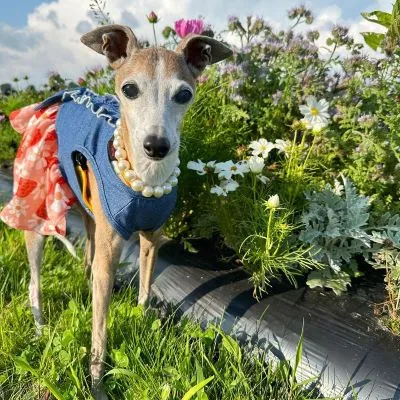 Italian Greyhound in a Strawberry Denim Dog Dress
Italian Greyhound in a Strawberry Denim Dog Dress
With proper care, including consistent grooming, cleaning, and attention to their diet and health, most dogs’ natural odors can be kept to a minimum. This ensures your beloved companion remains clean, pleasant-smelling, and a joy to have in your home.
Final Thoughts
The desire for a clean home and reduced allergy triggers doesn’t mean you have to forgo the companionship of a dog. The non-shedding and low-odor dog breeds discussed offer desirable traits for many prospective owners, blending the joy of pet ownership with practical benefits. With their minimal grooming needs (for shedding management) and reduced allergens, these dogs can make excellent household companions, particularly for those with sensitivities. Their often energetic yet friendly personalities enable them to thrive as loving family pets and even adaptable service animals. For those seeking an obedient, affectionate dog without the typical mess and odor, these breeds—such as the Poodle, Basenji, Maltese, and Chinese Crested—present fantastic options. By choosing one of these remarkable breeds and committing to a consistent grooming and care routine, you can enjoy a happier, cleaner, and more harmonious home environment with your beloved canine friend.
